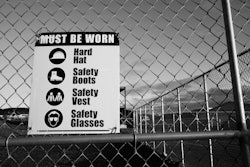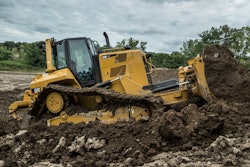
I’m passionate about safety. I think about it all the time, whether I’m at work or with my family. In the heavy equipment world, we face serious safety risks every day, and it can be a struggle to focus on what is really important.
Developing a culture of safety for your whole organization takes more than just reciting mantras like “Safety First.” You can take specific steps to build an extraordinary safety culture and eliminate at-risk behaviors.
Your safety culture is the atmosphere established upon the shared beliefs, attitudes, values and practices of your organization, crew or team, and shapes their collective behavior. When someone new is hired to work in your shop, they’ll start doing as the rest of the people in your shop do. People adjust their behavior to match the behavior of those around them. Your culture drives your team’s behavior.
If your organization has a strong safety culture, then everyone on your team feels responsible for safety 24/7—for themselves, their coworkers and their families. Team members will identify unsafe conditions or actions and they’ll act to correct those risks. They’ll have the courage to speak out when they see something unsafe, and feel empowered to stop unsafe work. The courage to act is a powerful part of your company’s safety culture. For many of us, including me, it is uncomfortable, difficult, and requires courage to ask someone you don’t know to change their safety behavior.
But speaking out when it’s difficult really matters. I want all of my employees to return home safe at the end of the day. I want them to carry safety values and processes home with them to keep their families safe too.
This isn’t just altruism. Injuries and accidents are expensive. When someone gets hurt, costs include their initial treatment and lost productivity time as well as administrative costs to investigate and report the incident, higher insurance rates, possible OSHA involvement, media attention, negative impacts to the organization’s reputation leading to loss of future work or contracts, and decreased employee morale.
It starts with the leader
Building a positive safety culture in my organization starts with me. When I walk through the shop or a job site, my people notice if I speak up about unsafe behaviors and they notice if I don’t. More importantly, they notice if I recognize all the great safety behaviors that are happening. They also notice if I don’t.
My first goal when observing my people is to find the good behaviors and recognize them for it. They also notice if I’m complying with safety protocols like wearing required safety gear even if I’m only going to be there for a few minutes. If I want them to take safety seriously, I have to show them by my example 100% of the time, no exceptions. Safety can never rest, nor can your example.
This kind of commitment means putting safety ahead of production, quality and profitability. It means recognizing and reinforcing good safety performance.
Let’s say a crew starts getting their projects done early, but they’re taking some shortcuts in safety procedures. How you and your organization’s leadership respond displays your organization’s true attitude about what’s valuable. To build a strong safety culture, everyone from your top managers to your newest employees needs to be committed to safety all the time, not just when it’s convenient or when a supervisor is watching.
The goal of a strong safety culture is not zero injuries. You can be lucky and have zero injuries. The goal of a strong safety culture is zero at-risk behaviors.
Tips on making safety personal
Getting that commitment requires knowing what your people care about. Nelson Mandela said: “If you talk to a man in a language he understands, that goes to his head. If you talk to a man in his language, that goes to his heart.”
Talk with your employees, find out who they are, who their families are, what they like to do, what they care about. Then if you see them not using proper safety gear, you can ask them why they’re willing to risk missing the next baseball game with their grandson, the next fishing trip with their daughter, the next evening out with their spouse. You can ask them to follow the policy and set a good example for everyone around them.
Creating a strong safety culture for your team also means getting everyone involved. Each person should be expected to practice observing safety issues. Encourage and welcome honest feedback from your team. Do they feel confident they can tell you what they need to tell you, even if it’s bad news? Have you coached them to recognize safety issues and report them to help identify problems before an injury occurs? Make sure everyone on your team understands what you expect from them, and knows that your goal is to help them get better.
How many safety people do you have in your company? Are you just counting safety specialists, or do you count everyone as a part of your safety team? Safety is every team member’s responsibility, not just the “safety guy’s” job.
Give safety-related assignments to each person. Do you have someone assigned to check the fire extinguishers and keep their inspections updated? Do you have a champion for your safety observation team? If everyone contributes, then your whole team moves from just participating in a program to ownership of a safety culture 24/7.
How often do you acknowledge and reward good behaviors? Plan ways to find appropriate safety behaviors and reward them right away.
Tell your employees “good job” when you see them following safety protocols. Send handwritten cards thanking them specifically for what they’re doing right and how they’re contributing to a strong safety culture. Use awards, team celebrations, gift cards, whatever works to reward the right behaviors.
Dwight Eisenhower said: “Leadership is the art of getting someone else to do something you want done because he wants to do it.” Find out what makes each person on your team tick, and relate safety personally to them.
Finally, write down and share your personal safety message. My personal safety message is that I choose to work safely for my wife Amber, daughter Riley, and my two sons Carl and Cooper, because every aspect of their life requires my participation. My example of safety will impact their behavior. I choose to lead with safety so that all of my people have the leadership, guidance and training necessary to not only work safely, but to also carry the culture of safety with them 24/7. I want to support them so they can live up to their own personal safety message.
Building a strong safety culture starts with you, the leader. Your team’s culture is being built each and every day, like it or not. Is that culture going to be poor, ordinary or extraordinary? It’s up to you. Jimmy Johnson said: "The difference between ordinary and extraordinary is that little extra.” Take action and go the extra mile to lead your team to an extraordinary safety culture.



















